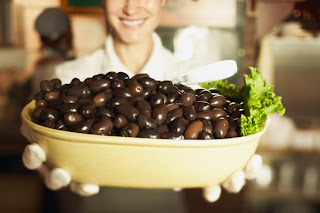By Dr. Madelyn Fernstrom
While consuming a variety of colorful foods is a direct connection to healthy eating, nutritious eating can be as easy as “black and white.” This week, I’m going to look at these two interesting contrasts for healthy eating.
Contrary to the popular notion that white foods are devoid of nutrients, many are valuable nutrient powerhouses. As with all nutrient-rich foods, you will reap optimal health benefits only when you consume them regularly. Aim for at least 5 servings of fruits and vegetables daily (or start by adding one more than you already eat now!).
Here are some of my favorites:
White Potatoes: Nature’s perfect carbohydrate – one the size of your fist is about 100 calories, and loaded with vitamin C, potassium, and fiber. It’s the oil, butter, sour cream, and cheese added to the spuds that gives them a bad nutritional rap.
Cauliflower: A member of the family of “cruciferous” vegetables (broccoli, Brussels sprouts, and cabbage are others), it is rich in the plant nutrient sulforaphane, shown in studies to be a cancer-fighting compound. It’s also a good source of vitamin C and fiber, and can be eaten raw, steamed, roasted, or even pureed and served as a side-dish like mashed potatoes.
Parsnips: This is my favorite root vegetable, low in calories and high in fiber (one cup gives you one-third of the fiber you need for a whole day). Parsnips have the appearance of “white carrots” and have a delicate natural sweetness when cooked. Not a veggie you’d consume raw, parsnips can be roasted, put into soups, or mashed like potatoes.
Onions and Garlic: There’s not a cuisine in the world that doesn’t use onions and garlic in most dishes. Part of the allicin family of plant nutrients, they are documented to support a healthy immune system. While some people prefer raw onions, their taste is muted with cooking, and they add amazing flavor with almost no calories. Try roasting garlic in the oven (bake a whole head wrapped in foil for about 45 minutes in a 400-degree oven) and use it as a spread to replace your butter or margarine for a healthy, low-calorie treat.
White Mushrooms: In addition to being a rich source of selenium (an antioxidant), mushrooms are a natural source of “umami” flavor, stimulating the fifth taste bud for a meaty, savory taste. No salt or added fat is needed when you add some mushrooms to your favorite recipes, including soups and side dishes. Slice or chop some raw mushrooms and add to your salad.









